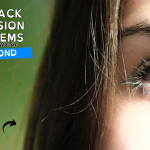What if your bathroom mirror could help you catch a serious health issue — in just 30 seconds?
While many people associate the thyroid with weight gain or fatigue, few know that early signs of thyroid dysfunction can be spotted with nothing more than a glass of water and a mirror. This simple trick might uncover a hidden thyroid problem long before it shows up on a blood test.
Let’s explore what this technique is, why it works, and what else your thyroid might be trying to tell you.

Table of Contents
Symptoms of Thyroid Disorders
| Symptom | Hypothyroidism (Underactive) | Hyperthyroidism (Overactive) |
|---|---|---|
| Energy Levels | Fatigue | Restlessness, insomnia |
| Weight | Weight gain (despite no appetite increase) | Weight loss (despite increased appetite) |
| Temperature Sensitivity | Sensitivity to cold | Sensitivity to heat |
| Heart Rate | Slow heart rate | Rapid or irregular heartbeat |
| Digestion | Constipation | Frequent bowel movements |
| Skin | Dry, coarse skin | Warm, moist skin |
| Hair | Thinning, dry hair | Brittle hair, possible hair loss |
| Mood | Depression, sluggishness | Anxiety, irritability |
| Menstrual Cycle (in women) | Heavy or irregular periods | Light or absent periods |
| Neck Area | Swelling or fullness | Swelling, possible goiter |
| Reflexes | Slowed reflexes | Hyperactive reflexes |
| Sleep | Excessive sleepiness | Trouble sleeping |
| Muscle Function | Weakness, cramps | Muscle tremors |
Do’s and Don’ts of the 30-Second Mirror Thyroid Check
| Do’s | Don’ts |
|---|---|
| Use a well-lit mirror for clear visibility. | Don’t perform the check in poor lighting or shadows. |
| Tilt your head back slightly for better neck view. | Don’t overextend your neck — it can distort the area. |
| Sip and swallow water slowly while watching. | Don’t rush the process or swallow without observing. |
| Repeat the test a few times to confirm results. | Don’t rely on just one quick look. |
| Check for lumps, bulges, or asymmetrical movement. | Don’t ignore visible swelling or changes in the neck. |
| Follow up with a doctor if you notice anything unusual. | Don’t self-diagnose or delay medical advice. |
| Stay calm and observant during the check. | Don’t panic if you see something — it may be harmless. |
| Perform this check every few months as a habit. | Don’t do it daily or obsessively. |
What Is the 30-Second Mirror Trick?
The mirror test is a quick self-examination that allows you to observe your thyroid gland for any visible abnormalities. All you need is:
- A mirror
- A glass of water
- Good lighting
How to Do It:

- Stand in front of a mirror so you can clearly see your neck.
- Tilt your head slightly back, exposing the area just below your Adam’s apple and above your collarbone.
- Take a sip of water and watch your neck as you swallow.
- Look for any lumps, bulges, or asymmetrical movements in the thyroid area as you swallow.
If you see anything unusual — such as a noticeable bump or an uneven rise — it may be a sign of an enlarged thyroid gland, a nodule, or another issue requiring medical attention.
Did You Know?
An estimated 60% of people with thyroid disease are unaware of their condition. This simple self-check could be the first clue.
What Does a Visible Lump Mean?
If you noticed a lump, bump, or swelling during the mirror test, it might be:
- A goiter – an enlarged thyroid gland, often due to iodine deficiency or autoimmune conditions.
- Thyroid nodules – usually benign, but some can be cancerous.
- Thyroid cancer – rare but important to rule out.
Any visible change should be assessed by a healthcare provider. Often, ultrasound imaging and blood tests are used to investigate further.
Who Should Try the Mirror Trick?
While everyone can benefit from this self-check, it’s especially useful for people who:
- Have a family history of thyroid disease
- Are over 30 years old
- Experience unexplained fatigue, weight changes, or mood swings
- Have swelling in the neck
- Are pregnant or postpartum (thyroid disorders often appear or worsen during these times)
Interesting Fact:
Women are up to 8 times more likely than men to develop thyroid issues, especially after pregnancy or menopause.
How Often Should You Do It?
You don’t need to do the mirror test every day. However, checking once every few months — or sooner if you notice symptoms — can be a proactive way to catch thyroid changes early.
It’s a 30-second commitment that could give you months or years of health advantage.
What to Do If You Notice Something Unusual
If your mirror check reveals a lump, swelling, or even a feeling of tightness in your throat:
- Don’t panic — most thyroid lumps are benign.
- Schedule an appointment with your doctor or endocrinologist.
- Prepare for additional tests such as:
- Thyroid blood panel (TSH, T3, T4)
- Neck ultrasound
- Fine-needle aspiration biopsy (if needed)
Final Thoughts
Your mirror might just be your first health screening tool. The 30-second thyroid self-check is easy, non-invasive, and surprisingly effective at catching visible signs of trouble.
With thyroid disorders on the rise globally, early detection is more crucial than ever.
So next time you grab a glass of water in front of the mirror — take a moment to look.
Your thyroid might be trying to tell you something.
Frequently Asked Questions (FAQs)
What exactly is the 30-second mirror trick for thyroid issues?
It’s a simple self-check where you watch your neck in a mirror while swallowing water to detect any unusual lumps, bulges, or swelling in the thyroid area, which may indicate thyroid enlargement or nodules.
Where should I be looking on my neck during the mirror test?
Focus on the area just below the Adam’s apple and above the collarbone. This is where the thyroid gland is located.
What does a lump or swelling mean?
A visible lump could indicate a goiter, thyroid nodule, or in rare cases, thyroid cancer. While most thyroid lumps are benign, it’s important to get them checked by a healthcare provider.
Can I rely solely on the mirror trick to diagnose thyroid disease?
No. The mirror trick is only a preliminary self-check. A proper diagnosis requires blood tests (TSH, T3, T4), ultrasound, and sometimes a biopsy.
How often should I perform this thyroid self-check?
Every 2–3 months is sufficient for most people. If you have a family history of thyroid issues or symptoms, you may want to check more frequently.
What are the early signs of thyroid problems I shouldn’t ignore?
Common early signs include unexplained fatigue, mood swings, weight changes, hair thinning, and neck swelling. These symptoms often go unnoticed or are mistaken for stress or aging.
Are thyroid issues more common in women?
Yes. Women are significantly more likely to develop thyroid disorders, especially during pregnancy, postpartum, and menopause due to hormonal changes.
What should I do if I notice something abnormal during the test?
Contact your doctor or an endocrinologist for further evaluation. They may order imaging or blood tests to confirm whether you have a thyroid condition.
Can thyroid issues be treated?
Yes. Most thyroid disorders can be managed effectively with medications, lifestyle adjustments, or surgery, depending on the cause and severity.





